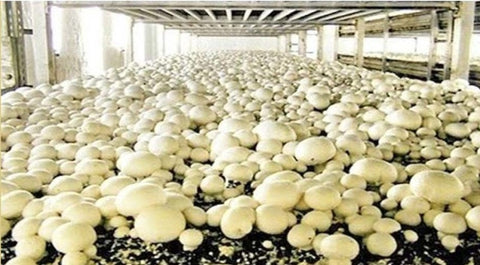Polyhouse Mushroom Farming for Profit, A Full Guide
Hello, polyhouse farmers! Today, we're here to share valuable information about Polyhouse Mushroom farming, a profitable practice. Mushrooms are a type of fungus that can be grown for food inside polyhouses. The most common mushroom variety grown is called Agaricus bisporus. Fungiculture is the term used for cultivating mushrooms and other fungi.
 Mushroom farming is a smart choice since it requires little investment and space. In India, it's becoming a popular way to earn extra income. Let's explore simple techniques and practices to make the most out of your polyhouse mushroom farming and boost your profits.
Mushroom farming is a smart choice since it requires little investment and space. In India, it's becoming a popular way to earn extra income. Let's explore simple techniques and practices to make the most out of your polyhouse mushroom farming and boost your profits.
Here are essential steps and practices to maximize your profits in polyhouse mushroom farming.
- Selecting the Right Mushroom Species The first crucial step is to choose the right mushroom species for cultivation. Agaricus bisporus, commonly known as button mushrooms, is the most popular choice for polyhouse farming due to its high demand and adaptability.
- Setting Up the Polyhouse A well-designed polyhouse is essential for successful mushroom cultivation. Ensure that the polyhouse provides adequate ventilation, temperature control, and humidity levels to mimic the ideal growing conditions for your chosen mushroom species.
Successful mushroom production in a polyhouse requires careful consideration of various factors.
Here are some essential factors to keep in mind for a thriving mushroom farm:
- Proximity to Farmer's House: The mushroom farm should be located close to the farmer's residence. This proximity allows for easy monitoring and timely interventions when required. It also ensures regular and attentive care of the mushrooms.
- Environmental Pollution: Choose a location away from industrial pollutants and chemical fumes. Mushrooms are sensitive to air quality.
- Abundant Water Supply: Adequate and consistent water supply is crucial for mushroom cultivation. Ensure that the farm has easy access to water sources.
- Availability of Raw Materials: Access to raw materials like compost, straw, sawdust, and other substrates is vital.
- Affordable Power Supply: Electricity is an important input in mushroom farming, especially for temperature and humidity control.
- Access to Labor: Mushroom farming may require manual labor for various tasks. Ensure that there is a readily available labor force in the area at affordable wages to assist in farm operations.
- Sewage Disposal: Provision for proper sewage disposal is essential for maintaining a clean and hygienic environment in and around the farm.
- Scope for Future Expansion: Plan for future growth and expansion of the mushroom farm. Adequate space and resources should be available to accommodate increased production if the demand for mushrooms rises.
Get in Touch Today:
Interested in profitable Polyhouse Mushroom Farming? Contact us now via email or WhatsApp to discover how to start and excel in urban mushroom cultivation. Let's grow together!




Leave a comment